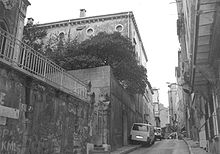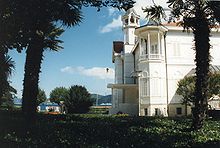Bosporus Germans
As Bosphorus German German be in Turkey called, their families often permanent in the metropolis already since the first half of the 19th century Istanbul lived. Their number in the Bosporus metropolis is around 25,000 today.
history
In general, the European foreigners living in Istanbul, for example Italian merchants, as well as the remnants of the Christian population ( Greeks , Armenians ) who have largely disappeared today and made up a significant proportion of Istanbul's population ( Greeks , Armenians ) are called Levantines (Leventi). Some districts of Istanbul, for example Beyoğlu ( Pera ), are still characterized by the Art Nouveau architecture that was widespread at the time.
The first German immigrants in Istanbul came as artisans and business people, later also as advisors to the German military missions to build up the Ottoman army , such as Colmar von der Goltz and Liman von Sanders . A critical chronicler of this time was the German journalist Friedrich Schrader , who lived and worked in Istanbul from 1891 to 1918. In his book "A Refugee Journey through Ukraine" he describes the fate of the German community in Istanbul after the defeat in 1918. Almost all Austrians and Germans were interned and deported by the Allies, with the exception of members of the Ottoman court such as the court conductor Paul Lange , Father of the well-known US conductor Hans Lange .
In 1852 the German hospital was founded in Istanbul, in 1868 the Deutsche Oberrealschule (today the German School Istanbul , Özel Alman Lisesi ), and later the İstanbul Lisesi .
During the time of National Socialism , numerous scientists and artists who had been expelled from Germany found refuge in Turkey , including well-known people such as the sculptor Rudolf Belling , the architect Bruno Taut and the composer Paul Hindemith . It is estimated that around 1000 people are directly affected, plus family members who have fled with them; Including Austrians who were forcibly German (or stateless) from 1938 onwards.
The third wave came since the 1970s , mainly through representatives of German business enterprises, as well as employees in their Turkish partner companies.
Institutions
A German community still exists today. The buildings that have existed for a long time are the former embassy building and today's consulate general near Taksimplatz, the park-like former summer residence of the German ambassador in Tarabya on the Bosporus, the German hospital , the İstanbul Lisesi and the German school in Istanbul. There are also German-speaking Protestant and Catholic parishes.
There are two associations of German immigrants: one is the older association "Teutonia" and the other is "Die Brücke". According to statements by the Goethe Institute from August 2005, 40,000 German citizens live in the 10 to 12 million city of Istanbul. According to the institute's further statements, more and more German artists also live in Istanbul. Kemal Derviş , the son of a German immigrant and a Turk, made it to the position of member of parliament and economics minister in Turkey. The Istanbul Department of the German Archaeological Institute is located in the building of the German Consulate General at Taksim Square. In the Cihangir district of Istanbul, the Orient-Institut Istanbul is the youngest independent research institute in the association of the German Humanities Institutes Abroad (DGIA).
See also
Remarks
- ↑ Baedeker Allianz Travel Guide Istanbul , page 17, accessed on July 16, 2009.
- ↑ German-speaking Turkish Internet Library: The German-Turkish educational relationships during the First World War ( Memento of the original from March 20, 2012 in the Internet Archive ) Info: The archive link was automatically inserted and not yet checked. Please check the original and archive link according to the instructions and then remove this notice.
- ↑ Dr Friedrich Schrader: A refugee trip through the Ukraine. Journal pages of my escape from Constantinople. JCB Mohr (Paul Siebeck), Tübingen 1919 : Online book from the Berlin State Library
- ↑ Website of the German hospital in Istanbul: Alman Hastanesi ( Memento of the original from May 9, 2011 in the Internet Archive ) Info: The archive link has been inserted automatically and has not yet been checked. Please check the original and archive link according to the instructions and then remove this notice.
- ↑ Information from the official website on the history of the German School in Istanbul: German School Istanbul
- ^ Deutscher Ärzteverlag GmbH, editorial office of the Deutsches Ärzteblatt: The German Hospital in Istanbul: An example of German-Turkish cooperation . Ed .: Karl-Herbert Wendt. 1998 ( aerzteblatt.de [accessed September 1, 2018]).
- ^ German Consulate General in Istanbul .
- ^ The Bridge eV Istanbul .
- ↑ Goethe Institute ( Memento from June 21, 2009 in the Internet Archive ).
- ↑ Kemal Dervis biography
Web links
- Information page of the German School Istanbul
- Official website of the Foundation for School Leavers of the German School Istanbul
- Second oldest German school in Istanbul Istanbul Erkek Lisesi
- German Embassy School Ankara / Istanbul
- Deutschlandfunk "Faces of Europe" on the German community in Istanbul March 28, 2009
literature
- Anne Dietrich: Being German in Istanbul. Nationalization and orientation in the German-speaking community from 1843 to 1956 Leske & Budrich, Opladen 1998 ISBN 3-8100-2188-1
- Barbara Radt: History of Teutonia. German club life in Istanbul 1847–2000 German Orient Institute, Istanbul 2001 ISBN 3-935556-97-7
- Hubert Wilschowitz: German-speaking Catholic community in Turkey 1954–1979. An overview in reports, essays and stories Blümel, Istanbul 1979
- Bispo, AA "Alemães na vida musical do Império Osmano ea emigração de" alemães do Bósporo "ao Novo Mundo: Paul Lange (1857-1919), Hans Lange (1884-1960) e Guiomar Novaes (1895-1979)". Revista Brasil-Europa: Correspondência Euro-Brasileira 144/15 (2013: 4). (Link)

